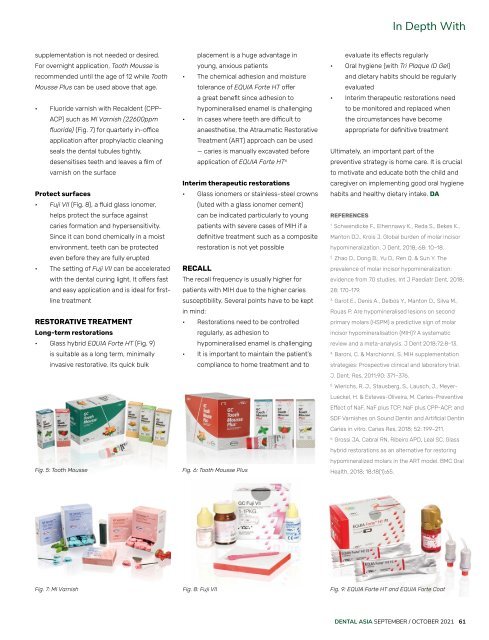Dental Asia September/October 2021
For more than two decades, Dental Asia is the premium journal in linking dental innovators and manufacturers to its rightful audience. We devote ourselves in showcasing the latest dental technology and share evidence-based clinical philosophies to serve as an educational platform to dental professionals. Our combined portfolio of print and digital media also allows us to reach a wider market and secure our position as the leading dental media in the Asia Pacific region while facilitating global interactions among our readers.
For more than two decades, Dental Asia is the premium journal in linking dental innovators and manufacturers to its rightful audience. We devote ourselves in showcasing the latest dental technology and share evidence-based clinical philosophies to serve as an educational platform to dental professionals. Our combined portfolio of print and digital media also allows us to reach a wider market and secure our position as the leading dental media in the Asia Pacific region while facilitating global interactions among our readers.
Create successful ePaper yourself
Turn your PDF publications into a flip-book with our unique Google optimized e-Paper software.
In Depth With<br />
supplementation is not needed or desired.<br />
For overnight application, Tooth Mousse is<br />
recommended until the age of 12 while Tooth<br />
Mousse Plus can be used above that age.<br />
• Fluoride varnish with Recaldent (CPP-<br />
ACP) such as MI Varnish (22600ppm<br />
fluoride) (Fig. 7) for quarterly in-office<br />
application after prophylactic cleaning<br />
seals the dental tubules tightly,<br />
desensitises teeth and leaves a film of<br />
varnish on the surface<br />
Protect surfaces<br />
• Fuji VII (Fig. 8), a fluid glass ionomer,<br />
helps protect the surface against<br />
caries formation and hypersensitivity.<br />
Since it can bond chemically in a moist<br />
environment, teeth can be protected<br />
even before they are fully erupted<br />
• The setting of Fuji VII can be accelerated<br />
with the dental curing light. It offers fast<br />
and easy application and is ideal for firstline<br />
treatment<br />
RESTORATIVE TREATMENT<br />
Long-term restorations<br />
• Glass hybrid EQUIA Forte HT (Fig. 9)<br />
is suitable as a long term, minimally<br />
invasive restorative. Its quick bulk<br />
Fig. 5: Tooth Mousse<br />
placement is a huge advantage in<br />
young, anxious patients<br />
• The chemical adhesion and moisture<br />
tolerance of EQUIA Forte HT offer<br />
a great benefit since adhesion to<br />
hypomineralised enamel is challenging<br />
• In cases where teeth are difficult to<br />
anaesthetise, the Atraumatic Restorative<br />
Treatment (ART) approach can be used<br />
— caries is manually excavated before<br />
application of EQUIA Forte HT 6<br />
Interim therapeutic restorations<br />
• Glass ionomers or stainless-steel crowns<br />
(luted with a glass ionomer cement)<br />
can be indicated particularly to young<br />
patients with severe cases of MIH if a<br />
definitive treatment such as a composite<br />
restoration is not yet possible<br />
RECALL<br />
The recall frequency is usually higher for<br />
patients with MIH due to the higher caries<br />
susceptibility. Several points have to be kept<br />
in mind:<br />
• Restorations need to be controlled<br />
regularly, as adhesion to<br />
hypomineralised enamel is challenging<br />
• It is important to maintain the patient’s<br />
compliance to home treatment and to<br />
Fig. 6: Tooth Mousse Plus<br />
evaluate its effects regularly<br />
• Oral hygiene (with Tri Plaque ID Gel)<br />
and dietary habits should be regularly<br />
evaluated<br />
• Interim therapeutic restorations need<br />
to be monitored and replaced when<br />
the circumstances have become<br />
appropriate for definitive treatment<br />
Ultimately, an important part of the<br />
preventive strategy is home care. It is crucial<br />
to motivate and educate both the child and<br />
caregiver on implementing good oral hygiene<br />
habits and healthy dietary intake. DA<br />
REFERENCES<br />
1.<br />
Schwendicke F., Elhennawy K., Reda S., Bekes K.,<br />
Manton DJ., Krois J. Global burden of molar incisor<br />
hypomineralization. J Dent, 2018; 68: 10–18.<br />
2.<br />
Zhao D., Dong B., Yu D., Ren Q. & Sun Y. The<br />
prevalence of molar incisor hypomineralization:<br />
evidence from 70 studies. Int J Paediatr Dent, 2018;<br />
28: 170-179.<br />
3.<br />
Garot E., Denis A., Delbos Y., Manton D., Silva M.,<br />
Rouas P. Are hypomineralised lesions on second<br />
primary molars (HSPM) a predictive sign of molar<br />
incisor hypomineralisation (MIH)? A systematic<br />
review and a meta-analysis. J Dent 2018;72:8-13.<br />
4.<br />
Baroni, C. & Marchionni, S. MIH supplementation<br />
strategies: Prospective clinical and laboratory trial.<br />
J. Dent. Res, 2011;90: 371–376.<br />
5.<br />
Wierichs, R. J., Stausberg, S., Lausch, J., Meyer-<br />
Lueckel, H. & Esteves-Oliveira, M. Caries-Preventive<br />
Effect of NaF, NaF plus TCP, NaF plus CPP-ACP, and<br />
SDF Varnishes on Sound Dentin and Artificial Dentin<br />
Caries in vitro. Caries Res, 2018; 52: 199–211.<br />
6.<br />
Grossi JA, Cabral RN, Ribeiro APD, Leal SC. Glass<br />
hybrid restorations as an alternative for restoring<br />
hypomineralized molars in the ART model. BMC Oral<br />
Health, 2018; 18;18(1):65.<br />
Fig. 7: MI Varnish<br />
Fig. 8: Fuji VII<br />
Fig. 9: EQUIA Forte HT and EQUIA Forte Coat<br />
DENTAL ASIA SEPTEMBER / OCTOBER <strong>2021</strong> 61


















